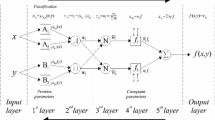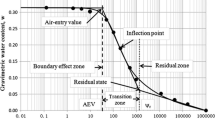Abstract
Correlations are very significant from the earliest days; in some cases, it is essential as it is difficult to measure the amount directly, and in other cases it is desirable to ascertain the results with other tests through correlations. Soft computing techniques are now being used as alternate statistical tool, and new techniques such as artificial neural networks, fuzzy inference systems, genetic algorithms, and their hybrids were employed for developing the predictive models to estimate the needed parameters, in the recent years. Determination of permeability coefficient (k) of soils is very important for the definition of hydraulic conductivity and is difficult, expensive, time-consuming, and involves destructive tests. In this paper, use of some soft computing techniques such as ANNs (MLP, RBF, etc.) and ANFIS (adaptive neuro-fuzzy inference system) for prediction of permeability of coarse-grained soils was described and compared. As a result of this paper, it was obtained that the all constructed soft computing models exhibited high performance for predicting k. In order to predict the permeability coefficient, ANN models having three inputs, one output were applied successfully and exhibited reliable predictions. However, all four different algorithms of ANN have almost the same prediction capability, and accuracy of MLP was relatively higher than RBF models. The ANFIS model for prediction of permeability coefficient revealed the most reliable prediction when compared with the ANN models, and the use of soft computing techniques will provide new approaches and methodologies in prediction of some parameters in soil mechanics.












Similar content being viewed by others
References
Shepherd RG (1989) Correlations of permeability and grain size. Ground Water 27(5):633–638
Yilmaz I (2006) Indirect estimation of the swelling percent and a new classification of soils depending on liquid limit and cation exchange capacity. Eng Geol 85:295–301
Alyamani MS, Sen Z (1993) Determination of hydraulic conductivity from complete grain-size distribution curves. Ground Water 31(4):551–555
Hazen A (1892) Some physical properties of sands and gravels. Massachusetts State Board of Health, Annual Report, pp 539–556
Uma KO, Egboka BCE, Onuoha KM (1989) New statistical grain-size method for evaluating the hydraulic conductivity of sandy aquifers. J Hydrol 108:343–366
Krumbein WC, Monk GD (1943) Permeability as a function of the size parameters of unconsolidated sands. Trans Am Inst Min Metall Petroleum Eng 151:153–163
Kozeny J (1953) Das wasser in boden, grundwasserbewegung. Hydraulik 280–445
Rawls WJ, Brakensiek DL (1989) Estimation of soil water retention and hydraulic properties. In: Morel-Seytoux HJ (ed) Unsaturated flow in hydrologic modeling theory and practice. Kluwer, Dordrecht, pp 275–300
Jabro JD (1992) Estimation of saturated hydraulic conductivity of soils from particle size distribution and bulk density data. J Am Soc Agric Eng 35(2):557–560
Sperry JM, Peirce JJ (1995) A model for estimating the hydraulic conductivity of granular material based on grain shape, grain size, and porosity. Ground Water 33(6):892–898
Lebron I, Schaap MG, Suarez DL (1999) Saturated hydraulic conductivity prediction from microscopic pore geometry measurements and neural network analysis. Water Resour Res 35(10):3149–3158
Cronican AE, Gribb MM (2007). Literature review: equations for predicting hydraulic conductivity based on grain-size data. (Supplement to Technical Note entitled: Hydraulic conductivity prediction for sandy soils published in Groundwater 42(3):459–464, 2004). http://coen.boisestate.edu/datedmaterial/images/LITERATURE_REVIEW-final.pdf
ASTM (1990) Sec. 4, Vol. 04.08, soil and rock; dimension stone; geosynthetics. American Society for Testing and Materials, Designation, pp D 421, D 422
ASTM (2006) Standard test method for permeability for granular soils. American Society for Testing and Materials, Designation, pp D 4234–D 4268
Jin Y, Jiang J (1999) Techniques in neural-network based fuzzy system identification and their application to control of complex systems. In: Leondes CT (ed) Fuzzy theory systems, techniques and applications. Academic Press, New York, pp 112–128
Kaynar O, Yilmaz I, Demirkoparan F (2011) Forecasting of natural gas consumption with neural network and neuro fuzzy system. Energy Educ Sci Technol A Energy Sci Res 26:221–238
Singh TN, Kanchan R, Verma AK, Singh S (2003) An intelligent approach for prediction of triaxial properties using unconfined uniaxial strength. Min Eng J 5:12–16
Yilmaz I (2009) Landslide susceptibility mapping using frequency ratio, logistic regression, artificial neural networks and their comparison: a case study from Kat landslides (Tokat-Turkey). Comput Geosci 35(6):1125–1138
Yilmaz I (2009) Comparison of landslide susceptibility mapping methodologies for Koyulhisar, Turkey: conditional probability, logistic regression, artificial neural networks, and support vector machine. Environ Earth Sci 61(4):821–836
Rumelhart D, McClelland J (1986) Parallel distributed processing: explorations in the microstructure of cognition. Bradford books, MIT Press, Cambridge
Yilmaz I (2010) The effect of the sampling strategies on the landslide susceptibility mapping by Conditional Probability (CP) and Artificial Neural Networks (ANN). Environ Earth Sci 60(3):505–519
Park J, Sandberg IW (1993) Approximation and radial basis function networks. Neural Comput 5:305–316
Broomhead DS, Lowe D (1988) Multivariable functional interpolation and adaptive networks. Complex Syst 2:321–355
Moody J, Darken CJ (1989) Fast learning in networks of locally-tunes processing units. Neural Comput 1(2):281–294
Park J, Sandberg IW (1991) Universal approximations using radial-basis-function network. Neural Comput 3(2):246–257
Xu K, Xie M, Tang LC, Ho SL (2003) Application of neural networks in forecasting engine systems reliability. Appl Soft Comput 2:255–268
Chen S, Cowan CFN, Grant PM (1991) Orthogonal least squares learning algorithm for radial basis function networks. IEEE Trans Neural Netw 2(2):302–309
Bianchini M, Frasconi P, Gori M (1995) Learning without local minima in radial basis function networks. IEEE Trans Neural Netw 6(3):749–755
Sheta AF, Jong KD (2001) Time-series forecasting using GA-tuned radial basis function. Inf Sci 133:221–228
Foody GM (2004) Supervised image classification by MLP and RBF neural networks with and without an exhaustively defined set of classes. Int J Remote Sens 25(15):3091–3104
Rivas VM, Merelo JJ, Castillo PA, Arenas MG, Castellano JG (2004) Evolving RBF neural networks for time-series forecasting with EvRBF. Inf Sci 165:207–220
Harpham C, Dawson CW (2006) The effect of different basis functions on a radial basis function network for time series prediction: a comparative study. Neurocomputing 69:2161–2170
Sarimveis H, Doganis P, Alexandridis AA (2006) Classification technique based on radial basis function neural networks. Adv Eng Softw 37:218–221
Zhang R, Huang G, Sundararajan N, Saratchandran P (2007) Improved GAP-RBF network for classification problems. Neurocomputing 70:3011–3018
Yu L, Lai KK, Wang S (2008) Multistage RBF neural network ensemble learning for exchange rates forecasting. Neurocomputing 71:3295–3302
Matlab 7.1 (2005) Software for technical computing and model-based design. The MathWorks Inc.
Alvarez GM, Babuska R (1999) Fuzzy model for the prediction of unconfined compressive strength of rock samples. Int J Rock Mech Min Sci 36:339–349
Finol J, Guo YK, Jing XD (2001) A rule based fuzzy model for the prediction of petrophysical rock parameters. L Petr Sci Eng 29:97–113
Yilmaz I, Yüksek AG (2008) An example of artificial neural network application for indirect estimation of rock parameters. Rock Mech Rock Eng 41:781–795
Yilmaz I, Yüksek AG (2009) Prediction of the strength and elasticity modulus of gypsum using multiple regression, ANN, ANFIS models and their comparison. Int J Rock Mech Min Sci 46(4):803–810
Jang JSR, Chuen-Tsai S (1995) Neuro-fuzzy modeling and control. Proc IEEE 83:378–406
Lee CC (1990) Fuzzy logic in control systems: fuzzy logic controller. I. IEEE Trans Syst Man Cybern 20:404–418
Lee CC (1990) Fuzzy logic in control systems: fuzzy logic controller. II. IEEE Trans Syst Man Cybern 20:419–435
Jang JR (1993) ANFIS: adaptive-network-based fuzzy inference system. IEEE Trans Syst Man Cybern 23:665–685
Loukas YL (2001) Adaptive neuro-fuzzy inference system: an instant and architecture-free predictor for improved QSAR studies. J Med Chem 44:2772–2783
SPSS 10.0.1 (1999) Statistical analysis software (Standard Version). SPSS Inc.
Acknowledgments
Authors thank anonymous reviewer for very constructive critics and suggestions that led to the improvement of the article.
Author information
Authors and Affiliations
Corresponding author
Rights and permissions
About this article
Cite this article
Yilmaz, I., Marschalko, M., Bednarik, M. et al. Neural computing models for prediction of permeability coefficient of coarse-grained soils. Neural Comput & Applic 21, 957–968 (2012). https://doi.org/10.1007/s00521-011-0535-4
Received:
Accepted:
Published:
Issue Date:
DOI: https://doi.org/10.1007/s00521-011-0535-4




